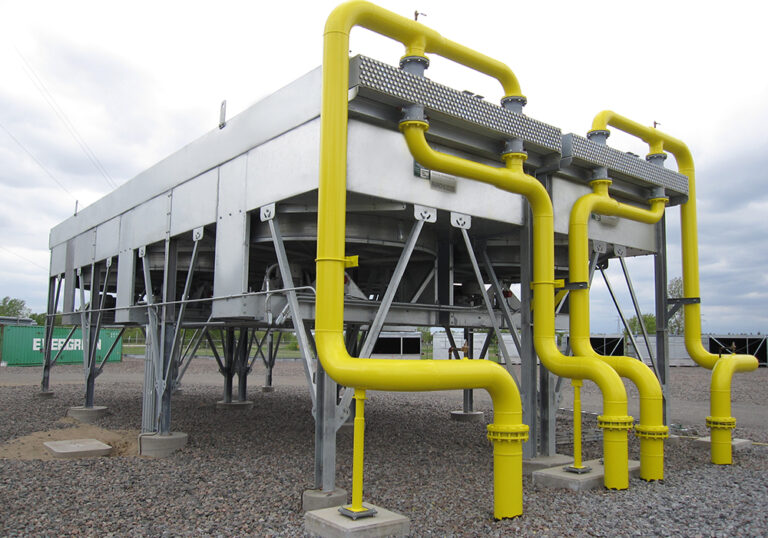Introduction
Waterless cooling solutions are revolutionizing the industrial cooling landscape by offering an alternative to traditional water-dependent systems. These innovative technologies, such as air-cooled heat exchangers and radiative cooling systems, eliminate the need for water in heat dissipation processes. By focusing on methods that utilize air and advanced materials, waterless cooling solutions address pressing environmental concerns, including water scarcity and pollution, while enhancing energy efficiency and reducing maintenance costs.
Types of Waterless Cooling Technologies
Air-Cooled Heat Exchangers
- Overview: These systems use fans to blow air across a heat exchanger surface where hot fluids are cooled by the ambient air. They are effective in transferring heat without water and are commonly used in power plants, industrial processes, and HVAC systems.
- Advantages: Air-cooled heat exchangers eliminate water consumption, reduce the risk of scaling and corrosion, and require less maintenance compared to water-based systems.Air Cooled Heat Exchangers
Radiative Cooling Systems
- Overview: Radiative cooling systems use thermal radiation to dissipate heat into the atmosphere. They are designed to maximize heat emission through specialized materials and surface coatings.
- Advantages: This technology is particularly effective in areas with clear skies and low humidity, where radiation can efficiently transfer heat away from the system.
Phase Change Material (PCM) Systems
- Overview: PCM systems use materials that absorb and release heat during phase transitions (e.g., solid to liquid). These materials can store thermal energy and release it slowly, reducing the need for continuous cooling.
- Advantages: PCMs provide energy storage capabilities and can improve system efficiency by reducing peak cooling loads.
Evaporative Air Coolers
- Overview: These coolers use the evaporation of water to cool air. While not entirely waterless, they use significantly less water compared to traditional cooling systems.
- Advantages: They are more water-efficient and can offer cooling benefits in dry climates where evaporation is effective.
Benefits of Waterless Cooling Solutions
Water Conservation
- Overview: Waterless cooling systems significantly reduce or eliminate the use of water, addressing water scarcity issues and supporting environmental sustainability.
- Benefits: Reduces the strain on local water resources and minimizes wastewater discharge.
Reduced Environmental Impact
- Overview: By avoiding water use, these systems help prevent the environmental issues associated with water-based cooling, such as thermal pollution and contamination.
- Benefits: Contributes to cleaner and more sustainable industrial practices.
Lower Maintenance Costs
- Overview: Waterless cooling systems often have fewer components prone to scaling, corrosion, and biological growth, reducing the need for frequent maintenance.
- Benefits: Decreases operational costs and downtime.
Energy Efficiency
- Overview: Advanced waterless cooling technologies can improve energy efficiency by optimizing heat transfer processes and reducing energy consumption.
- Benefits: Can lead to lower energy bills and a smaller carbon footprint.
Challenges and Considerations
Initial Cost
- Overview: The initial investment for waterless cooling systems can be higher compared to traditional water-based systems.
- Consideration: Companies should evaluate the long-term savings and benefits to justify the initial expenditure.
Effectiveness in High-Humidity Areas
- Overview: Some waterless cooling technologies, such as air-cooled heat exchangers, may be less effective in high-humidity environments where air has reduced cooling capacity.
- Consideration: Select technologies suited to specific environmental conditions.
Technological Maturity
- Overview: While waterless cooling solutions are advancing, some technologies are still emerging and may not be as widely adopted or proven as traditional systems.
- Consideration: Evaluate the technology’s track record and reliability before implementation.
Conclusion
Waterless cooling solutions represent a significant advancement in industrial cooling, offering environmental and operational benefits that align with modern sustainability goals. As industries continue to seek ways to reduce water usage and enhance efficiency, these innovative technologies provide a viable alternative to traditional water-based cooling systems. At Welltech Cooling Towers, we are committed to exploring and implementing cutting-edge cooling solutions that meet the evolving needs of our clients and contribute to a more sustainable future.

